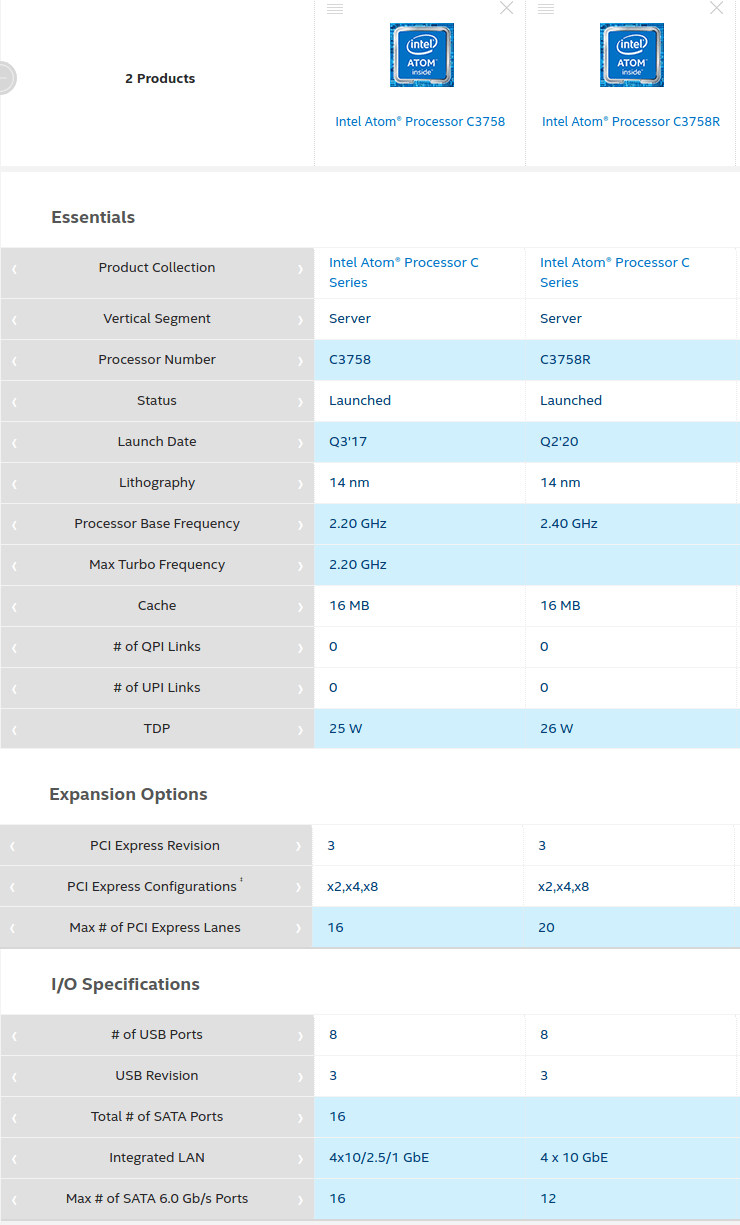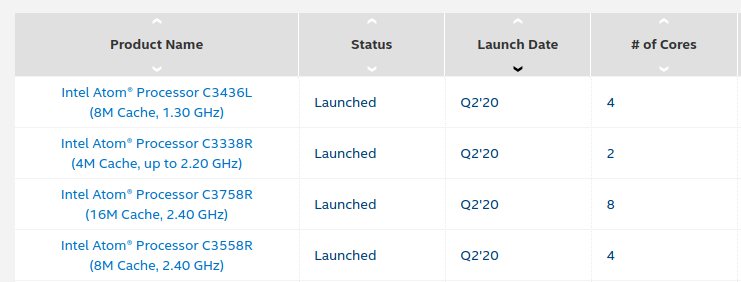Intel Atom C3000 “Denverton” processors were first unveiled in 2016 for low power servers, and are now found in fanless network appliances and server motherboards.
Intel has now quietly launched three new Atom Denverton “Refresh” and one “Low Power” processors, namely Intel Atom C3436L, C3338R, C3758R, and C3558R.
Highlights for the “refreshed” and current processors:
- Intel Atom C3436L quad-core processor @ 1.3 GHz with 8MB cache, 10.75W TDP
- Intel Atom C3338R dual-core processor @ 1.8 GHz / 2.2 GHz (Turbo) with 4MB cache, 10.5W TDP
- Intel Atom C3558R quad-core processor @ 2.4 GHz with 8MB cache, 17W TDP
- Intel Atom C3758R octa-core processor @ 2.4 GHz with 16MB cache, 26W TDP
- Intel Atom C3338 dual-core processor @ 1.5 GHz . 2.2 GHz (Turbo) with 4MB cache, 8.5W TDP
- Intel Atom C3558 quad-core processor @ 2.2 GHz with 8MB cache, 16W TDP
- Intel Atom C3758 octa-core processor @ 2.2 GHz with 16M, 25W TDP
So the refresh processors have a slightly higher base frequency combined with a higher TDP. Atom 3436L “Low Power” is also a new processor but does not have an exact match (e.g. no Atom 3436), and instead the closest is Intel Atom C3508 quad-core processor @ 1.60 GHz and 11.5 W TDP.
But are there more updates than just the TDP and base frequency? To find out, we’ve compared C3758R to C3758 to look at the details.

The two processors are pin-compatible so there’s a limited amount of changes Intel can make, and if the info on Intel Ark is correct, they appear to have switched some SATA ports for PCIe Express Lane in C3758R Denverton Refresh processor.
You’ll find more details about the new Refresh processors on Intel Ark.
Thanks to “NewsTip” for the tip.

Jean-Luc started CNX Software in 2010 as a part-time endeavor, before quitting his job as a software engineering manager, and starting to write daily news, and reviews full time later in 2011.
Support CNX Software! Donate via cryptocurrencies, become a Patron on Patreon, or purchase goods on Amazon or Aliexpress






Do these do anything useful for anyone here? I don’t have an application for these. What do others see as a use for them?
They support 4 x 10GbE, AES-NI and QAT (QuickAssist) and as such are a good choice for storage servers and the like. With 20 PCIe Gen3 lanes you can attach a bunch of SAS controllers (with SAS Expanders behind to attach a bunch of HDDs to each) or if the recent Open Compute proposal gets adoption in half a decade hundreds of NVMe HDDs behind inexpensive PCIe switches: https://146a55aca6f00848c565-a7635525d40ac1c70300198708936b4e.ssl.cf1.rackcdn.com/images/383af74f9a62c3e842197a3b82920f6082807a85.pdf Gen3 lanes with NVMe means 20 x 8 GT/s with 128b/130b coding –> plenty of bandwidth if the CPU can deliver (+19 GB/s). At least it’s more efficient than SAS HBAs… Read more »
FWIW: I have a NUC-like system with an Intel(R) Celeron(R) J4105 CPU @ 1.50GHz. It’s marketed as “Entry-level Budget” (which sounds bad), but it’s a very impressive machine for server stuff, plus VLC playing. It performs better than an old Xeon VPS I’ve access to.
So I trust these new Atoms are nice too for server / NUC stuff.